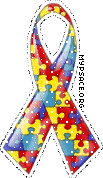Best video I've ever seen describing a life with an autistic child. "Autism Everyday" created by Autism Speaks
For Jadyne, the symptoms were clear early. At 8 weeks old, she still was not tracking objects with her eyes. Worse yet, her pupils were continuously dilated. My first concern was she was blind. Preliminary tests would rule this out but not explain this anomaly in her development. This continued for years, milestone after milestone not being met on time or not at all, test after test proving the milestone had not been met but without explanation as to why.
Probably the most notable and memorable of all this testing was pathology and audiology. Formal testing done at Children's Hospital of Columbus, OH showed Jadyne could indeed hear, but she had no level of receptive or expressive language. I asked both the specialist and her pediatrician how this was possible. How can she hear but not understand nor express, not even repeat, not gesture, nothing? It was clear to me, even then, even in my complete lack of understanding at that time of neurological processes, her brain simply wasn't processing what was entering it through her ears. Still yet, I was faced by impasse after impasse from doctors with the ever wonderful statement "We don't know. Let's just get her into therapy. Don't worry about a diagnosis. Just worry about treatment."
In treatment, the therapists begged for a diagnosis, while the doctors just wanted therapy. I was caught in the middle of a debate, unknown to me, had been ongoing for many many years. I fought to get Jadyne this elusive diagnosis, as the therapists were quite convincing that the earlier Jadyne was diagnosed, the higher her potential would be placed. Finally, after almost five years, Jadyne received her Autism Spectrum Diagnosis (first just PDD-NOS, Pervasive Developmental Disorder Not Otherwise Specified), and that launched us into the ASD community. Just a month later the American Pediatric Association announced screening would be mandatory for all children at the ages of one and two years old for............autism.
For Jadyne, the biggest challenge has been communication. She does present with stereotypical autistic behaviors such as hand-flapping, self-injury (hers manifesting in the form of pulling her hair, biting her hand, or banging her head), and both vocal and tactile "stimming". However, these stereotypical behaviors present most frequently when she is frustrated from her inability to communicate her thoughts, wants, and needs. She has a fully functioning brain for all the thought processes we have, thinks in complete sentences (proven by use of dynamic assistive communication devices such as the Dynavox), and yet somehow the words get stuck between thought and speech.
In essence, Dr. A. Jean Ayres, Ph.D., OTR, may have described it better than any of us ever can: "a traffic jam of the senses in the brain." Just as if you were blind, the rest of your senses would become hypersensitive, in autism, you are not blind, but your brain doesn't know that. The senses become either hyper or hyposensitive, a varying combination of the two. The DSM-IV describes the criteria for an Autism Diagnosis here.
For Jadyne, she can hear and now process what she hears, but she can't speak even on the same level as her three year old brother, and she is 7 1/2, although she is now considered verbal, however once was considered non-verbal. This in and of itself is progress, but as in everything, in Jadyne's time. She craves visual stimulation, such as a disco ball lit up in a dark room. She can't feel touch as much, although much more than before (once upon a time she couldn't even feel pain at all), and so she craves tactile stimulation through means of water play, massage therapy, and joint compression. She has never turned down any food, thus I must assume, without her words, she cannot taste or smell. However, that little girl LOVES to eat.
Communication remains our focus. Jadyne is blasted with a speech therapy technique of "waiting" daily: unless she makes at least an approximation of the word, she cannot have what she wants. This may seem cruel to those that don't live this life, but it has been indeed the only thing that has forced her into progress. She can sign, she can approximate, and for some things she can talk, but an absence of communication has become unacceptable. Everyday she fights to get her words out, and everyday, she gets just a little more accessible.
For more information on the sensory aspect of autism, visit:










0 comments:
Post a Comment